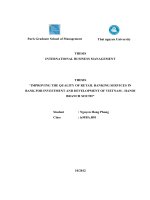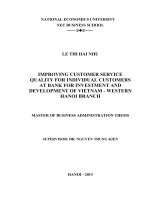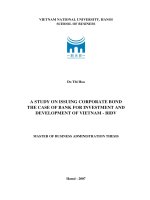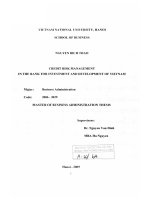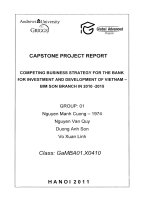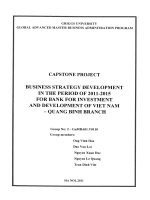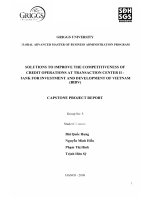some solutions to restrain credit risk at bank for investment and development of vietnam vinh phuc branch
Bạn đang xem bản rút gọn của tài liệu. Xem và tải ngay bản đầy đủ của tài liệu tại đây (342.42 KB, 64 trang )
i
DECLARATION
I hereby declare that the thesis entitled ‘Some solutions to restrain credit
risk at Bank for Investment and Development of Vietnam Vinh Phuc
Branch’ is entirely my own work. All of data in my thesis is used honestly. I
also declare that my researching results have not been previously or
concurrently published in any other works.
The Thesis Author
Nguyen Huy Binh
ii
ABSTRACT
The aims of this thesis are to clarify, explain basic theories of credit risk in
business activities of commercial banks and analyze, assess the risk situation
at BIDV Vinh Phuc branch. Moreover, the thesis also proposes some
solutions to restrain credit risk at the branch.
In the first part, literature reviews of commercial banks, bank credit and
banking risks are presented. Furthermore, this part focuses on explaining
general theories of credit risk such as causes, consequences, features and
signs of the risk.
Then the thesis mentions general introduction about BIDV Vinh Phuc
branch, overview of business operations of the branch is also provided in this
part. In addition, credit risk situation and the situation assessment at the
branch are analyzed to find out remarkable achievements and remaining
difficulties.
In the last part, the thesis suggests some solutions to restrict credit risk at
the branch and proposals to BIDV, State Bank of Vietnam and the
Government. The thesis hopes to offer all banks managers and credit staff
useful tips on preventing and constraining credit risk, and thus make a small
contribution to improve the business result of Vietnamese banking system.
iii
ACKNOWLEDGEMENT
This thesis would not have been possible without the support, the guidance
and the help of several individuals who, in one way or another, contributed
and extended their valuable assistance in the preparation and completion of
this study.
First and foremost, I would like to express my utmost gratitude to Ms Bui
Thi Bich Thuy, my supervisor, for her constructive feedbacks and useful
advices. This thesis would have remained a dream had it not been for her
persistent help.
I also would like to offer my sincere thanks to Mr. Kim Tuan Anh, director
of enterprise customer relation department. He advised me some research
ideas and assisted me a lot in collecting necessary data for the study. In
addition, I owe particular thanks to the staff of BIDV Vinh Phuc branch
whose support during my internship period I will never forget.
Last but not least, I am very grateful to my beloved parents, my numerous
friends who endured this long process with me and offered me great support,
encouragement and love at all times.
iv
ABBREVIATION
Agribank: Vietnam Bank for Agriculture and Rural Development
BIDV: Joint Stock Commercial Bank for Investment and Development of
Vietnam
CIC: Credit Information Center
EVN: Vietnam Electricity
NPL: Non-performing loans
SBV: State Bank of Vietnam
VNPT: Vietnam Posts and Telecommunications Group
v
LIST OF TABLES
Table 1: Business result
25
Table 2: Capital mobilization situation
26
Table 3: Credit activities situation
27
Table 4: Outstanding loans situation
28
Table 5: Overdue debts situation
29
Table 6: Overdue debts based on overdue time
30
Table 7: Overdue debts based on currency
31
Table 8: Overdue debts based on collateral
32
Table 9: Non-performing loans situation
33
Table 10: Non-performing loans structure
34
TABLE OF CONTENTS
DECLARATION……………………………………………………………i
ABSTRACT…………………………………………………………………ii
ACKNOWLEDGEMENT iii
ABBREVIATION………………………………………………………… iv
LIST OF TABLES………………………………………………………… v
TABLE OF CONTENTS 1
INTRODUCTION 1
CHAPTER 1 4
LITERATURE REVIEW 4
1.1 OVERVIEW OF COMMERCIAL BANK 4
1.1.1Definitions 4
1.1.2Characteristics of commercial banks 5
1.1.3Functions of commercial banks 6
1.2 OVERVIEW OF BANK CREDIT AND BANKING RISKS 7
1.2.1Bank credit 7
1.2.1.1Definitions 7
1.2.1.2Classification of bank credit 7
1.2.1.3Roles of bank credit 8
1.2.2Banking risks 10
1.2.2.1Definitions and nature of risk 10
1.2.2.2Definition of banking risks 10
1.2.2.3Classification of banking risks 10
1.3 CREDIT RISK IN BUSINESS OPERATION OF COMMERCIAL BANKS 13
1.3.1Definitions 13
1.3.2Features of credit risk 14
1.3.3Signs to identify credit risk 14
1.3.4Sources of credit risk 15
1.3.4.1Objective sources 15
1.3.4.2Subjective sources 16
1.3.5Impacts of credit risk 19
1.3.6Criteria of measuring credit risk 20
CHAPTER 2 22
CREDIT RISK RESTRAINT SITUATION AT BIDV VINH PHUC
BRANCH 22
2.1 GENERAL INTRODUCTION ABOUT BIDV VINH PHUC BRANCH 22
2.1.1Establishment and development history of BIDV 22
2.1.2General introduction about BIDV Vinh Phuc branch 23
2.1.3Organization structure of BIDV Vinh Phuc branch 24
2.2 OVERVIEW OF BUSINESS PERFORMANCE OF BIDV VINH PHUC BRANCH 25
2.2.1Business result 25
2.2.2Capital mobilization situation 26
2.2.3Credit activities situation 27
2.3 SITUATION OF CREDIT RISK AT BIDV VINH PHUC BRANCH 28
2.3.1Outstanding loans situation 28
Table 4: Outstanding loans situation 28
2.3.2 Overdue debts situation 29
2.3.3Non-performing loans situation 32
2.4 ASSESSING THE SITUATION OF RESTRAINING CREDIT RISK AT BIDV VINH PHUC BRANCH. .34
2.4.1Policy of managing credit risk at BIDV Vinh Phuc branch 34
2.4.2Remarkable achievements 34
2.4.3Remaining difficulties 35
2.4.4The reasons of credit risk at BIDV Vinh Phuc branch 35
2.4.4.1Objective reasons 35
2.4.4.2Subjective reasons 36
CHAPTER 3 38
SOLUTIONS TO PREVENT AND RESTRAIN CREDIT RISK AT
BIDV VINH PHUC BRANCH 38
3.1 ORIENTATION OF DEVELOPING CREDIT ACTIVITIES OF BIDV VINH PHUC BRANCH 38
3.1.1Orientation of developing credit activities of BIDV 38
3.1.2Orientation of developing credit activities of BIDV Vinh Phuc branch 39
3.2 SOLUTIONS TO PREVENT AND RESTRAIN CREDIT RISK AT BIDV VINH PHUC BRANCH 39
3.2.1Improving the quality of appraisal 39
3.2.2Complying with the credit process tightly 40
3.2.3Building durable relationships with customers 41
3.2.4Increasing secured loans 42
3.2.5Applying risk dispersion solutions 43
3.2.6Improving the effectiveness of internal control tasks 43
3.2.7Accomplishing the credit information system 44
3.2.8Enhancing the qualification of the branch’s credit staff 45
3.3 SOME PROPOSALS 46
3.3.1Proposals to the Government 46
3.3.2Proposals to State Bank of Vietnam 47
3.3.3Proposals to BIDV 48
CONCLUSION 50
REFERENCES 51
1
INTRODUCTION
1. Rationale of the study
Banking industry is always an indispensable part of every economy. The
efficient and effective performance of the banks over time is an index to
assess financial stability in any country. Thus, when a banking system faces
financial crises or even collapses, the economy will suffer serious
consequences such as high unemployment and inflation rate, fall in standard
of living, stagnant industry…The reasons for these crises are various but the
main one is credit risk.
Credit risk is one of the oldest and most frequent forms of risk faced by
banks. The higher the exposure of a bank to credit risk, the higher the
tendency of the banks to suffer losses and vice versa. In addition, a bank
exists not only to accept deposits but also to grant credit facilities so it is
inevitably exposed to the risk.
In recent years, banks in Vietnam have experienced a lot of difficulties in
business activities due to credit risk. Therefore, preventing and restricting the
risk are extremely urgent and essential tasks. However, Vietnamese banking
industry has not been stable yet because it is in the process of reform and
integration with the banking sector of other countries. Moreover, the credit
operation of commercial banks is not very efficient and safe. Thus, how to
limit credit risk effectively is always a big challenge for all banks in Vietnam
in general and for Joint Stock Commercial Bank for Investment and
Development of Vietnam (BIDV) in particular.
From the above reasons, it is, to my mind, an urgent need to curb credit
risk at BIDV. Therefore, in my graduation thesis, I decide to choose the topic
Nguyen Huy Binh CQ47/51.01
2
‘‘Some solutions to restrain credit risk at Bank for Investment and
Development of Vietnam Vinh Phuc branch’’.
2. Aims of the study
The specific aims of the research are clarifying and explaining basic
theories of credit risk at commercial banks. Besides, the writer analyzes and
assesses credit risk situation and reasons of the risk at BIDV Vinh Phuc
branch. At last, some solutions are proposed to restrict the risk at the branch.
3. Methods of the study
In order to perform this study, I firstly choose the method of analyzing,
summarizing, listing, comparing, and synthesizing materials and books to
form the theoretical background.
In the process of writing this paper, I also base myself on the knowledge I
have learnt from my teachers, my supervisor and from other references.
Last but not least, my own experiences gained during the internship period
at BIDV Vinh Phuc branch and in learning English for Finance and
Accounting at Academy of Finance provide me favorable conditions to
complete the study.
4. Scope of the study
This paper is intended, as the title suggests: ‘Some solutions to restrain
credit risk at Bank for Investment and Development of Vietnam Vinh Phuc
Branch’, to mention basic theories of credit risk at commercial bank and
situation, reasons of the risk and solutions to solve this matter at BIDV Vinh
Phuc branch. In addition, all information about business performance of
BIDV Vinh Phuc branch from 2010 to 2012 is also used for the study.
5. Organization of the study
Nguyen Huy Binh CQ47/51.01
3
The study is divided into three parts:
The first part is the introduction including the rationale, aims, methods,
scope, organization and significance of the study.
The second part is the main part of the paper with three chapters:
Chapter I deals with general theories about commercial bank, bank credit,
banking risks and credit risk in business activities of commercial banks.
Chapter II refers to the situation of restraining credit risk at BIDV Vinh
Phuc branch.
Chapter III mentions some solutions to restrain credit risk at BIDV Vinh
Phuc branch.
The last part is the conclusion that summarizes the content of the paper and
gives some suggestions for further study.
6. Significance
It is hoped that this study, to some extent, will be a helpful reference
material for banks’ credit staff and bankers to get more solutions to prevent
and constrain credit risk.
Nguyen Huy Binh CQ47/51.01
4
CHAPTER 1
LITERATURE REVIEW
1.1 OVERVIEW OF COMMERCIAL BANK
1.1.1 Definitions
Establishment and development history of commercial banks has lasted for
hundreds of years and it always associates with the commodity economy.
Along with the development of commodity economy, commercial banks have
evolved a lot to become one of the most important financial institutions in an
economy.
The definition of commercial banks is various. According to Basel Accord
II, commercial banks are defined as financial institutions that provide a list of
various financial services, especially credit, savings, payment services and
perform financial functions. French Banking Law in 1941 defined commercial
banks as enterprises whose usual functions are accepting money through
different forms and using those resources for their own sake in discount,
credit and financial activities. In U.S, commercial banks are regarded as
money-dealing enterprises that specialize in supplying financial services and
operate in financial service industry.
In Vietnam, Banking Ordinance issued on May 23
rd
1990 by State
Committee stated: ‘‘commercial banks are money dealing organizations
whose main and usual activities are accepting deposits from customers with
the responsibility of repaying and using them for lending activities or
performing discounts, making as means of payment’’. According to Law on
Vietnam credit institutions in October 1997 and Law on amending and
supplementing articles of law on Vietnam credit institutions in 2004,
Nguyen Huy Binh CQ47/51.01
5
commercial banks are credit institutions permitted to conduct all banking
activities and other relating business ones.
In general, commercial banks are financial institutions whose main
function is providing financial services such as accepting deposits, giving
business loans and auto loans, mortgage lending, and basic investment
products like savings accounts and certificates of deposit.
1.1.2 Characteristics of commercial banks
One of the most typical characteristics of commercial banks is running for
profit. Commercial banks operate with the objective of making profit so their
fee structure and interest rate are designed with the intention of making
money for owners and shareholders.
The second significant feature is being owned privately. Commercial
banks are owned by private individuals or collections of private individuals
acting as shareholders. They are regulated by Government institutions and
must follow all applicable laws, but they are not owned by the Government.
Private individuals who run commercial banks are responsible for major
policy decisions.
Another feature is that business operations of commercial banks always
face risks. Commercial banks are among the major financial intermediaries in
the marketplace and the nature of banking business is always associated with
risks so risks are unavoidable to the banks. Consequently, commercial banks
are always exposed to the risks that affect both the banks and their customers.
Last but not least, commercial banks’ activities depend very much on
customer’s trust. Main functions of commercial banks are mobilizing capital
from customers and lending that capital to others so customers always play an
important role in business strategies of every bank. Without customers and
Nguyen Huy Binh CQ47/51.01
6
their trust, banks can hardly exist and develop. Thus, all banks always try
their best to gain customer’ belief through discount and preference interest
rate. However, after recent collapses and bankruptcies of some banks,
regaining customers’ trust is really a tough challenge for all banks.
1.1.3 Functions of commercial banks
The most important function of commercial banks is credit intermediation
function. Being credit intermediaries, commercial banks become the
connection between customers who have capital deficits and ones with capital
surpluses. This function benefits not only customers but also the banks and
the economy.
Another important function of commercial banks is payment
intermediation function. In more details, the banks conduct payments by
transferring money from this account to others following their customers’
requests. The function makes commercial banks become ‘‘a treasurer’’ of
enterprises and individuals because the banks keep customers’ money and
carry out payment for them.
Last but not least, commercial banks carry out a function of creating
money. This is the result of two above functions. The creation of money
means that after the process of lending and transferring money of commercial
banks, a new amount of deposit which is much more than the initial one is
created. Therefore, performing this function, commercial banks can create a
huge amount of money which is multiple larger than the money issued by
central bank.
Nguyen Huy Binh CQ47/51.01
7
1.2 OVERVIEW OF BANK CREDIT AND BANKING RISKS
1.2.1 Bank credit
1.2.1.1 Definitions
It is very essential to study definition of credit at first to understand more
about bank credit. Credit is a contractual agreement in which a borrower
receives something of value now and agrees to repay the lender at some date
in the future, generally with interest. The term also refers to the borrowing
capacity of an individual or company.
Therefore, bank credit can be defined as the amount of credit available to
a company or individual from the banking system. It is the aggregate of the
amount of funds financial institutions are willing to provide to an individual
or organization. A company or individual's bank credit depends on both the
borrower's capacity to repay and the overall amount of credit available in the
banking system.
1.2.1.2 Classification of bank credit
Based on different criteria, bank credit can be classified as the following:
Based on the loan term:
Short-term credit: are loans with a term of less than 1 year. These loans
are often used to support payment, supplement temporary shortage of working
capital for enterprises or satisfy daily consuming demand of individuals.
Medium-term credit: are loans with a term of 1 year to 5 years. Mid-term
loans are used for investing, purchasing fixed assets, technical upgrading and
production expansion.
Long-term credit: are loans with a term of more than 5 years to finance
capital for construction, upgrade and expand large-scale production.
Nguyen Huy Binh CQ47/51.01
8
Based on guaranteed assets:
Credit with guaranteed assets: are loans with mortgage, pledge, collateral
or guarantee from the third party.
Credit without guaranteed assets: are loans without mortgage, pledge or
guarantee from the third party. These loans depend very much on customers’
prestige and banks often perform these loans to their traditional customers.
Based on loan purpose:
Good production and circulation credit: are loans provided for enterprises
to do business.
Consuming credit: are loans provided for individuals to satisfy their
consuming demands such as buying houses, cars, real estate…
Based on transaction methods between banks and customers:
Direct credit: are loans lent directly from banks to borrowers and the
borrowers pay back the loans directly to the banks without financial
intermediaries.
Indirect credit: are loans provided for borrowers from other financial
intermediaries.
1.2.1.3 Roles of bank credit
Firstly, bank credit contributes to stabilize, expand business and economic
growth. As a main channel to provide capital for the economy, this type of
credit always satisfies capital demands of customers, hence it ensures the
continuous development of business. In the market economy, the credit is one
of the sources to form fixed and working capital of enterprises so it also helps
the enterprises to expand production scale, promote technical improvements
to gain more and more profit. Moreover, bank credit is the bridge between
Nguyen Huy Binh CQ47/51.01
9
saving and investment. It not only stimulates saving but also supplies capital
for investing. Thus, the credit plays an important role in economic growth.
In addition, bank credit improves the efficiency of using capital. A main
characteristic of this type of credit is borrowers’ responsibility of paying back
the principal and the interest. On using loans from banks, enterprises and
individuals must respect all terms and conditions of the credit contract, repay
the loans and interest in a timely manner. Thus, the borrowers always have to
try to use the loans effectively. This will enhance the efficiency of using
capital and prevent capital waste.
Besides, the credit is a tool to implement macroeconomic targets such as
stabilizing prices, economic development, restraining inflation, increasing
employment rate and social security policies of the Government. To achieve
these targets, the Government needs to use bank credit because the state
budget is limited whereas all targets need money to be accomplished. In
addition, this type of credit is also used to implement monetary policies and
regulate money circulation. Social security policies such as improving
education, health care quality and living environment… are usually financed
from domestic and foreign loans of the Government. Therefore, without bank
credit, the Government can hardly conduct macroeconomic targets and social
security policies effectively.
Last but not least, this type of credit also contributes to develop foreign
trade. Nowadays, economic growth of a country always associates with the
world economy and the credit has become an important mean to link
countries’ economy together. To developing countries in general and Vietnam
in particular, bank credit plays a key role in promoting export, import and
especially modernizing and industrializing the economy.
Nguyen Huy Binh CQ47/51.01
10
1.2.2 Banking risks
1.2.2.1 Definitions and nature of risk
All activities of individuals or groups in society have different goals.
However, sometimes the goals cannot be achieved as expected due to risk. So
what is risk? There is no official definition of risk so far. According to
Wikipedia, risk is a probability or threat of damage, injury, liability, loss, or
any other negative occurrence that is caused by external or internal
vulnerabilities, and that may be avoided through preemptive action. The
Oxford English Dictionary defines risk as the possibility of loss, injury, or
other adverse or unwelcome circumstance; a chance or situation involving
such a possibility. Economists consider risk as the probability that an actual
return on an investment will be lower than the expected one. Although risk is
defined variously, its nature is uncertainty or unexpected occurrence of an
event that will harm the subject.
1.2.2.2 Definition of banking risks
Banking risks are those risks the banks are confronted with in their current
operation and the risks may have potentially negative effect on banks’
business. There are some types of banking risks which can be classified as the
following.
1.2.2.3 Classification of banking risks
Credit risk:
The most significant and persistent risk faced by banks is credit risk. It
may be defined as the risk that a counterparty of a financial transaction will
fail to make repayments according to the term and conditions of the contract,
thus causing the asset holder to suffer loss. This failure may be the result of
Nguyen Huy Binh CQ47/51.01
11
bankruptcy, a temporary change in market conditions, or other factors
adversely affecting the borrower’s ability to repay.
The most obvious example of credit risk is the risk that a customer will fail
to repay a loan. However, it is important to appreciate that credit risk
exposure extends to a large variety of bank’s activities including the
extensions of commitments and guarantees, acceptances, trade finance
transactions, placements and the range of capital markets’ instruments activity
such as foreign exchange, futures, swaps, bonds, options, equities and bullion.
In addition, credit risk may also arise from off balance sheet transactions
and take the form of delivery or settlement risk. Because credit risk can cause
serious consequences to banks so how to restrict credit risk is always a top
concern of bank managers.
Interest rate risk:
A fundamental banking objective is to borrow funds at one rate and to lend
them at a higher one. Interest rate risk refers to the financial risks caused by
the interest rate fluctuations that affect both the profit obtained by the client
and the indebtedness degree to the bank. A major increase of the interest rate
may determine a financial pressure for the client’s activities, which may result
in customers’ inability to repay the amounts.
Liquidity risk:
Liquidity risk occurs when a bank is not able to meet its cash or payment
obligation. The risk arises because cash flows on assets and liabilities do not
match. Due to the size and the spread of the resources, the bank is often called
to borrow ‘‘short’’ and lend ‘‘long’’. This gives rise to the risk that depositors
may seek to withdraw their funds and the bank may not be able to effect
Nguyen Huy Binh CQ47/51.01
12
repayment except by raising additional deposit at a higher cost, or by a forced
sale of assets, perhaps at a loss.
Thus, an important aspect of banking activities is the fact that the
depositors may withdraw their money whenever they want. If a bank cannot
meet these obligations, the customer’s trust in the bank will diminish, even in
the whole banking system. The customer may not wish anymore to deposit
their money at banks, and there may appear massive withdrawals of funds that
can cause a negative effect over the national economy.
Foreign exchange risk:
Foreign currency trading is one of the main business operations of banks.
These activities help to diversify the economy and support enterprises in
importing and exporting sector. Foreign exchange risk is the risk that occurs
in foreign currency trading due to unexpected fluctuation of exchange rate.
No one can predict what the exchange rate will be in the next period, it can
move in either upward or downward direction regardless of what the
estimates and predictions were. This uncertain movement poses a threat to the
earnings and capital of bank, if such a movement is in undesired and
unanticipated direction. If the bank selling rate is more than the buying one,
the bank will make profit and vice versa.
Operational risk:
Operational risk is the risk of loss resulting from inadequate internal
processes or external events. This risk includes legal risk but excludes
strategic and reputational risk. Complex transactions are more likely to face
the risk than simple ones. This type of risk is also the result of failure in
managing human resources such as fraud, mistakes, abuse, immoral and
disqualification of bank employees. The more staff banks hire, the more likely
Nguyen Huy Binh CQ47/51.01
13
the banks suffer the risk. Inadequate system is only a reason of this risk but it
can affect all other risks in banks. Moreover, other external events relating to
facilities problems, legal or politic change, and even natural disasters also
contribute to increase operational risk.
1.3 CREDIT RISK IN BUSINESS OPERATION OF
COMMERCIAL BANKS
1.3.1 Definitions
Credit risk is considered as the most frequent and significant risk that
commercial banks face in their business operation. According to Thomas
P.Fitch, credit risk is the risk that occurs when borrowers fail to meet their
contractual obligation to repay a debt in accordance with agreed terms. It is
the main risk in business activities of commercial banks. In the book ‘‘Risk
Management in Banking’’ by Joe Besis, credit risk is the loss resulting from
customers’ inability to repay or poor credit quality of the loan. World Bank
defines credit risk as the possibility that borrowers cannot repay interest or the
principal on due date.
In Vietnam, according to Article 02, Clause 01 of Decision
No.493/2005/QD-NHNN on debt classification, provisioning and use of
provisions to handle credit risk in the banking activity of credit institutions
issued on April 22
nd
, 2005, credit risk is the possibility of loss in banking
activities of credit institutions because of the customers’ failure to meet their
obligations as committed.
Thus, the risk can be understood that a borrower will default on any type
of debt by failing to make payments which it is obligated to do. It is an
inherent characteristic of banks because lending activities always face risks
Nguyen Huy Binh CQ47/51.01
14
and losses. The risk occurs not only in lending but also in financial leasing,
discounting, security transactions, Swaps and guarantee activities.
1.3.2 Features of credit risk
Firstly, credit risk is indirect. This feature arises from the reason that in
credit relationship, there are always capital transfers between customers and
banks and differences between ownership and right to use of capital after a
certain period of time. Thus, customers’ ineffective use of capital will cause
this type of risk to themselves and banks.
Secondly, credit risk is various and complicated. Credit activities are
extremely diverse and complex, every credit relation has its own
characteristics so the risk may occur in a variety of forms due to various
reasons. Therefore, many solutions are needed to prevent and limit the risk.
Last but not least, credit risk is an inherent one in banking activities. When
a transaction is incurred, a certain degree of credit risk is also identified. The
reason is that there are mismatches in information between lenders and
borrowers. The lenders always want to collect all exact information about the
borrowers and their real lending demand while the borrowers only want to
provide good information for the lenders. Besides, customers’ business
performances are often affected a lot by subjective and objective factors.
Thus, credit activities of banks always associate with this type of risk.
1.3.3 Signs to identify credit risk
Although credit risk is inherent in banking activities, it can be recognized
easily by some signs. Once banks pay attention to the signs, they can find it
easier to handle the risk.
Nguyen Huy Binh CQ47/51.01
15
Most of the signals arise from customers. The customers tend to cause the
risk to banks when they accept to borrow with a high interest rate and
frequently ask banks to fix the due date. Besides, they don’t want to provide
their real financial statements for banks and try to exaggerate items on the
balance sheet. In addition, there are big differences among true revenue, profit
and expected ones without reasonable reasons. Moreover, banks may face the
risk when their customers use the loans for wrong purposes in accordance
with terms and conditions in the credit contract.
There are also signs of credit risk from credit policies of banks. Banks are
more likely to suffer this type of risk when they conduct lending activities
without mortgages, pledges and guarantees from third party for new
customers. Another typical signal is that credit staff do not comply strictly
with credit process, they often ignore necessary steps in the process on
lending to the traditional customers.
1.3.4 Sources of credit risk
Nowadays, credit risk is a top concern of all banks managers. To minimize
the risk in banking business operations, banks need to figure out the sources
of the risk.
1.3.4.1 Objective sources
Political and legal environment:
A stable political regime contributes to the economic growth and
accelerates effectiveness in business activities of enterprises. In contrast, the
instability of the regime may result in employees’ strikes and financial crises
so enterprises’ operation faces a lot of difficulties, hence credit risk is more
likely to occur. Moreover, inflexible regulations and policy of the
Government may cause the risk to banks because the banking system is
Nguyen Huy Binh CQ47/51.01
16
extremely sensitive to changes of law. Thus, banks should forecast the trend
of changes in law environment to have appropriate development orientation
and credit policy.
Economic environment:
Every change in economic environment affects credit risk. The growth or
recession of the economy impacts the success or failure of borrowers. During
the period of economic growth, the borrowers can make much profit from
selling goods, investing, brokerage…and repay the loans easily. However, a
downturn in the economy may lead to a decline in revenue and profit of
enterprises so they will find it difficult to pay back the loans on due date to
banks. The more recessive the economy is, the more likely banks and
customers suffer the risk.
Besides, inflation also has a bad effect on business operation of
enterprises. Inflation increases manufacturing expense, hence enterprises have
to borrow money from banks to ensure continuous production. In addition,
inflation decreases customers’ consuming demand so the enterprises have
difficulties in gaining profit from selling goods. Consequently, the enterprises
may default on the loan.
Sources from nature:
Natural disasters such as floods, earthquakes, storms, droughts…always
cause a great deal of damage to people. Borrowers also suffer the damage that
ruins their business. As a result, they will fail to make repayments which it is
obligated to do and their failure causes credit risk to banks.
1.3.4.2 Subjective sources
Sources from customers:
Nguyen Huy Binh CQ47/51.01
